Opinion & Analysis
The myth behind the “one-way miss”
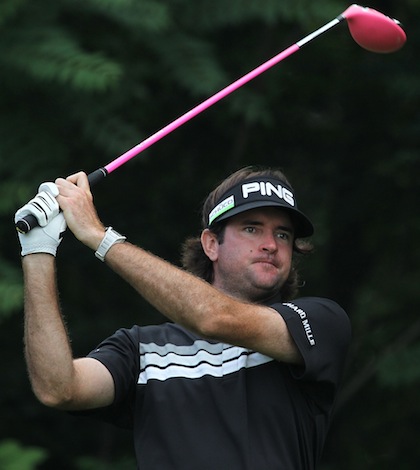
We often hear from professional golfers how important it is to have a “one way miss’”and to be able to “take one side of the golf course out of play” in order to drive the ball more effectively. However, statistical evidence indicates that this is not quite an accurate depiction of how the best golfers in the world effectively drive the ball.
A metric that I have explored quite frequently is “miss bias.” This is the percentage of time a player misses a fairway right or left. What I have found is that there is no direction that is better to miss the fairway. Having a right miss bias is equal to having a left miss bias. Typically, what is more important is the ratio of the miss bias.
I feel the best indicator of driving success is to look at the top players in my “Driving Effectiveness” ranking. Driving Effectiveness is based on algorithm that considers the following metrics:
- Driving distance
- Fairway percentage
- Average distance from the edge of fairway (on drives that miss the fairway)
- Percentage of fairway bunkers hit
- Missed fairways and other (shots that end up in the trees, water, O.B, etc.)
Here is a table with the current top-20 players in Driving Effectiveness and their Miss Bias.
As the chart shows, 13 of the top-20 ranked players have a miss bias that is no more than 55 percent either way.
Now, let’s look at this year’s players with miss biases that are greater than 60 percent and their rankings in Driving Effectiveness.
Tour golfers can strike the ball well off the tee with a large miss bias, however, not one of these players on the list is ranked in the top 20 in Driving Effectiveness. Furthermore, let’s take a look at the players on that list that played last on the Tour last season.
The chart shows that if the player’s miss bias in 2012 was less than 60 percent, they were typically more effective off the tee. Rod Pampling, Rory McIlroy, John Huh and Tiger Woods are examples of golfers that had a miss bias less than 60 percent in 2012 and also drove the ball much more effectively as well.
What the data tells me is that trying to taking one side “out of play” is not great advice if you wish to be an effective driver of the ball. There are likely too many holes where the golfer has to favor the right side or the left side.
What I’ve seen from my tour players is that having a “one-way miss” is actually more about having a “one-way curve.” If a golfer tend to hit a draw with their stock swing, they’ll be best served to continue to hit draws or straight balls off the tee. When many golfers try to alternate between draws and fades, however, they often risk getting into trouble and being less effective off the tee.
If a player has a more extreme miss bias, that tends to indicate a common “big miss” that they cannot rid themselves of. And that miss may cost them down the line.
I recommend that amateur golfers forget about having a “one-way miss.” They need to concern themselves with getting the ball to curve one way, and identify that common “big miss” and work to make it a smaller one.
- LIKE7
- LEGIT1
- WOW0
- LOL0
- IDHT1
- FLOP1
- OB2
- SHANK0
19th Hole
Vincenzi’s 2024 Zurich Classic of New Orleans betting preview

The PGA TOUR heads to New Orleans to play the 2023 Zurich Classic of New Orleans. In a welcome change from the usual stroke play, the Zurich Classic is a team event. On Thursday and Saturday, the teams play best ball, and on Friday and Sunday the teams play alternate shot.
TPC Louisiana is a par 72 that measures 7,425 yards. The course features some short par 4s and plenty of water and bunkers, which makes for a lot of exciting risk/reward scenarios for competitors. Pete Dye designed the course in 2004 specifically for the Zurich Classic, although the event didn’t make its debut until 2007 because of Hurricane Katrina.
Coming off of the Masters and a signature event in consecutive weeks, the field this week is a step down, and understandably so. Many of the world’s top players will be using this time to rest after a busy stretch.
However, there are some interesting teams this season with some stars making surprise appearances in the team event. Some notable teams include Patrick Cantlay and Xander Schauffele, Rory McIlroy and Shane Lowry, Collin Morikawa and Kurt Kitayama, Will Zalatoris and Sahith Theegala as well as a few Canadian teams, Nick Taylor and Adam Hadwin and Taylor Pendrith and Corey Conners.
Past Winners at TPC Louisiana
- 2023: Riley/Hardy (-30)
- 2022: Cantlay/Schauffele (-29)
- 2021: Leishman/Smith (-20)
- 2019: Palmer/Rahm (-26)
- 2018: Horschel/Piercy (-22)
- 2017: Blixt/Smith (-27)
2024 Zurich Classic of New Orleans Picks
Tom Hoge/Maverick McNealy +2500 (DraftKings)
Tom Hoge is coming off of a solid T18 finish at the RBC Heritage and finished T13 at last year’s Zurich Classic alongside Harris English.
This season, Hoge is having one of his best years on Tour in terms of Strokes Gained: Approach. In his last 24 rounds, the only player to top him on the category is Scottie Scheffler. Hoge has been solid on Pete Dye designs, ranking 28th in the field over his past 36 rounds.
McNealy is also having a solid season. He’s finished T6 at the Waste Management Phoenix Open and T9 at the PLAYERS Championship. He recently started working with world renowned swing coach, Butch Harmon, and its seemingly paid dividends in 2024.
Keith Mitchell/Joel Dahmen +4000 (DraftKings)
Keith Mitchell is having a fantastic season, finishing in the top-20 of five of his past seven starts on Tour. Most recently, Mitchell finished T14 at the Valero Texas Open and gained a whopping 6.0 strokes off the tee. He finished 6th at last year’s Zurich Classic.
Joel Dahmen is having a resurgent year and has been dialed in with his irons. He also has a T11 finish at the PLAYERS Championship at TPC Sawgrass which is another Pete Dye track. With Mitchell’s length and Dahmen’s ability to put it close with his short irons, the Mitchell/Dahmen combination will be dangerous this week.
Taylor Moore/Matt NeSmith +6500 (DraftKings)
Taylor Moore has quickly developed into one of the more consistent players on Tour. He’s finished in the top-20 in three of his past four starts, including a very impressive showing at The Masters, finishing T20. He’s also finished T4 at this event in consecutive seasons alongside Matt NeSmith.
NeSmith isn’t having a great 2024, but has seemed to elevate his game in this format. He finished T26 at Pete Dye’s TPC Sawgrass, which gives the 30-year-old something to build off of. NeSmith is also a great putter on Bermudagrass, which could help elevate Moore’s ball striking prowess.
- LIKE7
- LEGIT3
- WOW1
- LOL1
- IDHT0
- FLOP3
- OB1
- SHANK1
19th Hole
Vincenzi’s 2024 LIV Adelaide betting preview: Cam Smith ready for big week down under

After having four of the top twelve players on the leaderboard at The Masters, LIV Golf is set for their fifth event of the season: LIV Adelaide.
For both LIV fans and golf fans in Australia, LIV Adelaide is one of the most anticipated events of the year. With 35,000 people expected to attend each day of the tournament, the Grange Golf Club will be crawling with fans who are passionate about the sport of golf. The 12th hole, better known as “the watering hole”, is sure to have the rowdiest of the fans cheering after a long day of drinking some Leishman Lager.
The Grange Golf Club is a par-72 that measures 6,946 yards. The course features minimal resistance, as golfers went extremely low last season. In 2023, Talor Gooch shot consecutive rounds of 62 on Thursday and Friday, giving himself a gigantic cushion heading into championship Sunday. Things got tight for a while, but in the end, the Oklahoma State product was able to hold off The Crushers’ Anirban Lahiri for a three-shot victory.
The Four Aces won the team competition with the Range Goats finishing second.
*All Images Courtesy of LIV Golf*
Past Winners at LIV Adelaide
- 2023: Talor Gooch (-19)
Stat Leaders Through LIV Miami
Green in Regulation
- Richard Bland
- Jon Rahm
- Paul Casey
Fairways Hit
- Abraham Ancer
- Graeme McDowell
- Henrik Stenson
Driving Distance
- Bryson DeChambeau
- Joaquin Niemann
- Dean Burmester
Putting
- Cameron Smith
- Louis Oosthuizen
- Matt Jones
2024 LIV Adelaide Picks
Cameron Smith +1400 (DraftKings)
When I pulled up the odds for LIV Adelaide, I was more than a little surprised to see multiple golfers listed ahead of Cameron Smith on the betting board. A few starts ago, Cam finished runner-up at LIV Hong Kong, which is a golf course that absolutely suits his eye. Augusta National in another course that Smith could roll out of bed and finish in the top-ten at, and he did so two weeks ago at The Masters, finishing T6.
At Augusta, he gained strokes on the field on approach, off the tee (slightly), and of course, around the green and putting. Smith able to get in the mix at a major championship despite coming into the week feeling under the weather tells me that his game is once again rounding into form.
The Grange Golf Club is another course that undoubtedly suits the Australian. Smith is obviously incredibly comfortable playing in front of the Aussie faithful and has won three Australian PGA Championship’s. The course is very short and will allow Smith to play conservative off the tee, mitigating his most glaring weakness. With birdies available all over the golf course, there’s a chance the event turns into a putting contest, and there’s no one on the planet I’d rather have in one of those than Cam Smith.

Louis Oosthuizen +2200 (DraftKings)
Louis Oosthuizen has simply been one of the best players on LIV in the 2024 seas0n. The South African has finished in the top-10 on the LIV leaderboard in three of his five starts, with his best coming in Jeddah, where he finished T2. Perhaps more impressively, Oosthuizen finished T7 at LIV Miami, which took place at Doral’s “Blue Monster”, an absolutely massive golf course. Given that Louis is on the shorter side in terms of distance off the tee, his ability to play well in Miami shows how dialed he is with the irons this season.
In addition to the LIV finishes, Oosthuizen won back-to-back starts on the DP World Tour in December at the Alfred Dunhill Championship and the Mauritus Open. He also finished runner-up at the end of February in the International Series Oman. The 41-year-old has been one of the most consistent performers of 2024, regardless of tour.
For the season, Louis ranks 4th on LIV in birdies made, T9 in fairways hit and first in putting. He ranks 32nd in driving distance, but that won’t be an issue at this short course. Last season, he finished T11 at the event, but was in decent position going into the final round but fell back after shooting 70 while the rest of the field went low. This season, Oosthuizen comes into the event in peak form, and the course should be a perfect fit for his smooth swing and hot putter this week.

- LIKE12
- LEGIT3
- WOW1
- LOL1
- IDHT0
- FLOP1
- OB1
- SHANK1
Opinion & Analysis
The Wedge Guy: What really makes a wedge work? Part 1

Of all the clubs in our bags, wedges are almost always the simplest in construction and, therefore, the easiest to analyze what might make one work differently from another if you know what to look for.
Wedges are a lot less mysterious than drivers, of course, as the major brands are working with a lot of “pixie dust” inside these modern marvels. That’s carrying over more to irons now, with so many new models featuring internal multi-material technologies, and almost all of them having a “badge” or insert in the back to allow more complex graphics while hiding the actual distribution of mass.
But when it comes to wedges, most on the market today are still single pieces of molded steel, either cast or forged into that shape. So, if you look closely at where the mass is distributed, it’s pretty clear how that wedge is going to perform.
To start, because of their wider soles, the majority of the mass of almost any wedge is along the bottom third of the clubhead. So, the best wedge shots are always those hit between the 2nd and 5th grooves so that more mass is directly behind that impact. Elite tour professionals practice incessantly to learn to do that consistently, wearing out a spot about the size of a penny right there. If impact moves higher than that, the face is dramatically thinner, so smash factor is compromised significantly, which reduces the overall distance the ball will fly.
Every one of us, tour players included, knows that maddening shot that we feel a bit high on the face and it doesn’t go anywhere, it’s not your fault.
If your wedges show a wear pattern the size of a silver dollar, and centered above the 3rd or 4th groove, you are not getting anywhere near the same performance from shot to shot. Robot testing proves impact even two to three grooves higher in the face can cause distance loss of up to 35 to 55 feet with modern ‘tour design’ wedges.
In addition, as impact moves above the center of mass, the golf club principle of gear effect causes the ball to fly higher with less spin. Think of modern drivers for a minute. The “holy grail” of driving is high launch and low spin, and the driver engineers are pulling out all stops to get the mass as low in the clubhead as possible to optimize this combination.
Where is all the mass in your wedges? Low. So, disregarding the higher lofts, wedges “want” to launch the ball high with low spin – exactly the opposite of what good wedge play requires penetrating ball flight with high spin.
While almost all major brand wedges have begun putting a tiny bit more thickness in the top portion of the clubhead, conventional and modern ‘tour design’ wedges perform pretty much like they always have. Elite players learn to hit those crisp, spinny penetrating wedge shots by spending lots of practice time learning to consistently make contact low in the face.
So, what about grooves and face texture?
Grooves on any club can only do so much, and no one has any material advantage here. The USGA tightly defines what we manufacturers can do with grooves and face texture, and modern manufacturing techniques allow all of us to push those limits ever closer. And we all do. End of story.
Then there’s the topic of bounce and grinds, the most complex and confusing part of the wedge formula. Many top brands offer a complex array of sole configurations, all of them admittedly specialized to a particular kind of lie or turf conditions, and/or a particular divot pattern.
But if you don’t play the same turf all the time, and make the same size divot on every swing, how would you ever figure this out?
The only way is to take any wedge you are considering and play it a few rounds, hitting all the shots you face and observing the results. There’s simply no other way.
So, hopefully this will inspire a lively conversation in our comments section, and I’ll chime in to answer any questions you might have.
And next week, I’ll dive into the rest of the wedge formula. Yes, shafts, grips and specifications are essential, too.
- LIKE32
- LEGIT7
- WOW1
- LOL1
- IDHT2
- FLOP3
- OB1
- SHANK3
-

 19th Hole2 weeks ago
19th Hole2 weeks agoDave Portnoy places monstrous outright bet for the 2024 Masters
-

 19th Hole2 weeks ago
19th Hole2 weeks agoTiger Woods arrives at 2024 Masters equipped with a putter that may surprise you
-

 19th Hole2 days ago
19th Hole2 days agoJustin Thomas on the equipment choice of Scottie Scheffler that he thinks is ‘weird’
-

 19th Hole2 days ago
19th Hole2 days ago‘Absolutely crazy’ – Major champ lays into Patrick Cantlay over his decision on final hole of RBC Heritage
-

 19th Hole3 weeks ago
19th Hole3 weeks agoReport: Tiger Woods has ‘eliminated sex’ in preparation for the 2024 Masters
-

 19th Hole1 week ago
19th Hole1 week agoTwo star names reportedly blanked Jon Rahm all week at the Masters
-

 19th Hole1 week ago
19th Hole1 week agoReport: LIV Golf identifies latest star name they hope to sign to breakaway tour
-

 19th Hole1 week ago
19th Hole1 week agoNeal Shipley presser ends in awkward fashion after reporter claims Tiger handed him note on 8th fairway

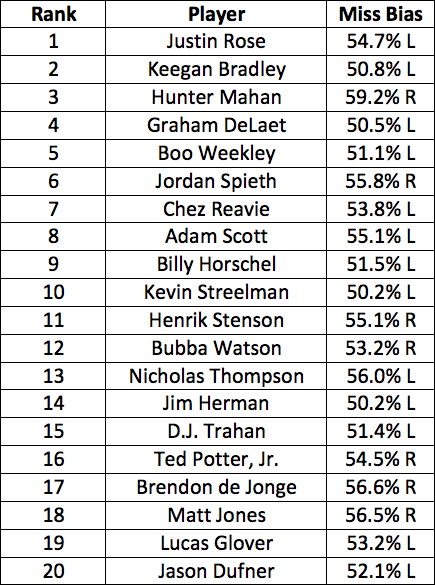
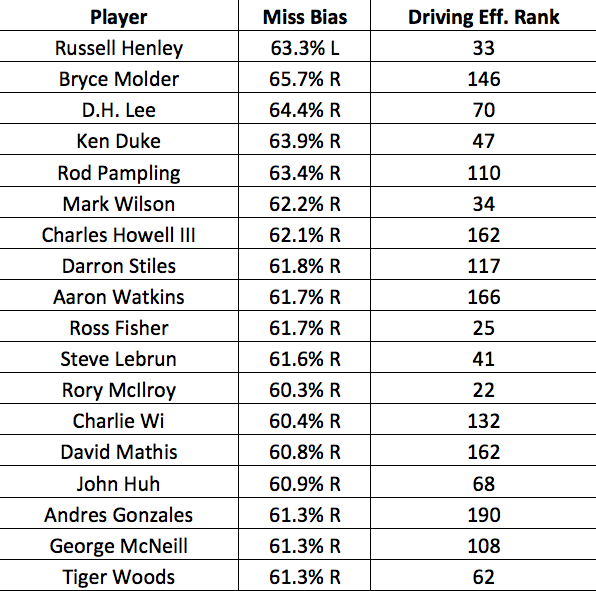
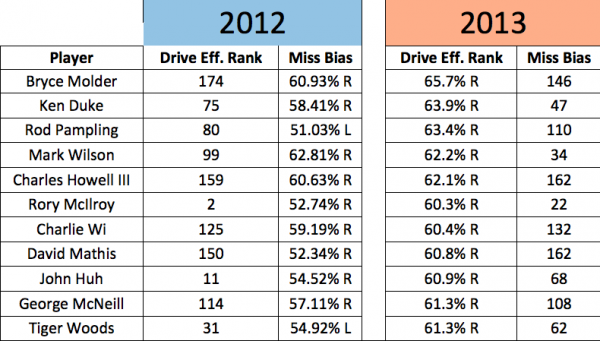


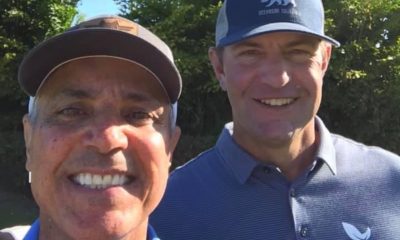









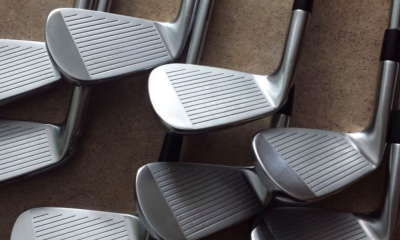













Pingback: Tips in Beating a Pro Golfer – Aymerich Golf Club
TheFightingEdFioris
Sep 4, 2014 at 1:28 pm
Cool article by the way. Always enjoy your writing.
TheFightingEdFioris
Sep 4, 2014 at 1:28 pm
No look into what they actually scored on the hole and/or the actual distance they missed the fairway by? Were Tiger’s driving stats better in 2012 when he missed it left more than right? Apparently… But did the left miss cost him a shot in a few tournaments? Absolutely (see 2012 PGA when Rory missed left off the tee basically zero times)
I am not disagreeing, you’ve clearly done a lot more homework on this than I have. But would you agree Rich that the biggest advantage to feeling that you have a one way miss is mental? To stand on a tee box and know you can swing as hard as you want and not even sniff the OB left, or not worry about blocking it high and right.
Jtriscott
Aug 7, 2013 at 12:06 pm
I think this is pretty simple…
There is usually a side on the hole that is a much better miss (ie, hazard, OB, etc).
For the RH golfer:
If the good miss is RIGHT, I just weaken my grip and make sure I am not going to HOOK the ball.
If the good miss is LEFT, I strengthen my grip and make sure I am not going to SLICE the ball.
It works all the time, 60% of the time!
Geoffrey
Apr 9, 2014 at 12:09 pm
Is there any way to interpret a players extreme left vs right miss tendency to determine if a player’s primary shot is a draw vs a fade?
Mike
Jul 31, 2013 at 9:01 pm
This article could not be more on point! The best players know which direction their ball will curve on less than perfect shots. When they talk about eliminating one side of the course, what they mean is eliminating one direction the ball will curve on their poor shots. And Matteo, as a club fitter you should know that tour players have their own clubs built with exactly this in mind. Nice article.
CT
Jul 31, 2013 at 11:22 am
“What I’ve seen from my tour players is that having a “one-way miss” is actually more about having a “one-way curve.” ”
You should make that the title of the article, and the first sentence summary to set the writing, because this information is great stuff. Because that what it is – it’s all about the favored curve.
Richie Hunt
Jul 31, 2013 at 2:22 pm
Thanks for the kind words. I had a little difficulty coming up with a good title.
Dustin
Jul 30, 2013 at 8:52 pm
The one way miss is a draw or fade. I can miss a fade down the left and a draw down the right. Point is I want a shot that I know will fade or draw.
Steve
Jul 30, 2013 at 5:53 pm
Good article…working with tour players it makes perfect sense. Keep sharing 🙂
Brian
Jul 30, 2013 at 12:09 pm
While the data is interesting, I think the conclusion you are drawing from it is a bit heavy. Just because a player misses in one direction more often off the tee, doesn’t mean they are neccesarily trying to miss in that direction. And, in my opinion, a player, especially a pro, who is truly trying to “miss” in one direction would see something more like 70/30 at the worst, not 60/40. With that said, from the pro golf that I’ve watched in person, most pros are paying no attention to the old addage and just hitting towering bombs right down the pipe. With the low spin driver and ball technology available, and the caliber of swings, it just seems to be the norm. Perhaps the approach data is more rellevant?
Also, the math behind what you consider a “myth” is that if you can eliminate one side of the course, your bigger misses are less threatening. Think about it. If you have a 20 yard wide fairway, and you know you won’t miss left, you can aim at the left side of the fairway and afford a 0-20 yard miss to the right side of the fairway. If you have no bias, then you aim down the middle, and you can afford a 0-10 yard miss in either direction.
And let’s be honest, nobody, not even the pros, can truly eliminate one side of the course. If a RH golfer has a trusty fade, at some point they are going to double cross and yank one left. That’s the true definition of a miss, otherwise it’s just a shot shape.
Richie Hunt
Jul 31, 2013 at 9:08 am
Brian,
I agree with what you are saying about the player ‘not trying to miss in that direction.’ I think those with a larger miss bias are likely struggling with a shot that does not prevent them from missing towards that bias.
Dixie Flatline
Jul 30, 2013 at 9:58 am
I think the author is taking the phrase “one way miss” and “taking one side of the golf course out of play” too literally. Those phrases are used in a discussion of ball flight off the tee, not where the ball actually lands.
Richie Hunt
Jul 30, 2013 at 10:05 am
Perhaps that is the case and I can respect your opinion on that. I know that when discussing this with some golfers, even some of my Tour clients, they think of it in very literal terms.
The main point I was trying to convey is that the miss biases on Tour are not as pronounced as some people tend to think it is and those with more pronounced miss biases tend to not hit it as well off the tee.
steff
Jul 30, 2013 at 9:23 am
A one way miss has nothing to do with the fairway! It depends on were you aim and the knowlage the if you miss it wont go left or right.
Example: You have OB left but you open up the hole the more left you aim.
This is were a “one way miss” comes in handy. You can aim close to the OB and you feel confident that if you hit it good it will go were you aim. But a miss will never go OB! A bad shot will allways go to the right and not OB.
Jokke
Jul 30, 2013 at 3:38 am
I totally agree with the above comments that the data used in this article has nothing to do with one-way misses. None whatsoever.
stephenf
Jul 30, 2013 at 3:33 am
It may be that the secondary goal of “taking one side out of play” isn’t particularly valid, but the primary reason to establish a go-to consistent curve is simply that you’ll have the whole width of a fairway to miss (or something close to it) rather than only half the fairway (as happens if you don’t know which way you’re likely to curve it, and you have to hit it down the middle and hope for the best).
Mateo
Jul 30, 2013 at 1:33 am
Wow. utterly pointless article.
This dude must be a 25 handicap.
Eliminating a side of the golf course has nothing to do with what side of the fairway you miss. It has to do with the 15 of variables he obviously will never understand.
As a teacher, a club fitter, a golf nut, and a scratch player with years of tourney experience……………. I advise everyone to disregard this article.
Richie Hunt
Jul 30, 2013 at 10:01 am
I fully stand behind what I have written.
The article is discussing about missing either left or right. The ‘one way miss’ is often described as if you miss, you miss one direction or the other (left or right).
As we can see, once the ratio is greater than 55/45 the player tends to become less effective off the tee. Particularly as the ratio gets to 60/40 or even a greater discrepancy.
I even stated in this very article that there is no difference in somebody who tends to miss left versus misses right. It’s the size of the ratio that matters more.
Why?
I know the obvious variables that can come into play with the way a hole is designed. But the *point* that has been missed is that in general, Tour players do not have very pronounced miss biases and the ones that do; generally do not drive the ball as well.
And I do not think it’s fair to assume that I’m a 25 handicapper just like it would not be fair for me to assume that you are a poor instructor because you were unable to comprehend my obvious points.
Nick
Jul 30, 2013 at 4:35 pm
Haha, you must be trolling dude. Either that or you like to run your mouth about people you don’t know.
Nick
Jul 30, 2013 at 4:36 pm
My previous comment was directed at Mateo if that wasn’t clear.
Mat
Jul 29, 2013 at 7:03 pm
Very low correlation here.
Imagine a hole that goes water-rough-fw-rough. Player aims centre-right to ensure that only a left miss would be a strong left miss to get wet. Whether the player hits the fairway or not is almost irrelevant; it’s that the ball isn’t wet.
If you’re not sure why, flip the hole; rough-fw-rough-water. It’s effectively even.
If you want to study misses like this, correlate the number of penalising hazards a player hits vs their average fairways hit. In other words, do they put it in the water more because they ignore the one-way miss. Or, an even stronger cause-effect is to see how often players miss to the opposite side of water in the rough.
Bryce Molder, at 66%, simply means he misses right more often when he misses at a rate of not quite 1 in 3. Assuming he hits 8 of 14 in a round, that means that he’s going to miss 4 right, 2 left. Just one shot per round would flip that, and he’s the worst there is.
I’m not buying this one as-is.
Richie Hunt
Jul 30, 2013 at 10:10 am
Mat,
I think you’re missing the point that players with more pronounced miss biases tend to be less effective off the tee. I also point out players like Tiger, Rory, John Huh and Rod Pampling as players whose miss biases became much more pronounced this year and they are now less effective off the tee.
My Driving Effectiveness algorithm takes into consideration shots that go in hazards (i.e. Missed Fairway – Other %) and fairway bunkers hit % as well as Avg. Distance from Edge of Fairway. I could certainly look at the correlation just between miss bias and Missed Fairway Other and fairway bunker %, but the big picture here is that when it comes to all of the main factors that relate to effectiveness off the tee; the bigger miss biases tend to make golfers less effective off the tee.
Brian
Jul 29, 2013 at 5:40 pm
I think you missed the point of having a one way miss. It’s not so much which side you miss it on, it’s that is usually the same side that you miss it on.
The point is to always miss right, or always miss left. The side doesn’t matter, just that you aren’t missing left half the time and right half the time. These stats have absolutely nothing to do with the point of a one way miss.
Nick
Jul 30, 2013 at 4:29 pm
Did you read his article? He’s saying that while people say exactly what you said, a statistical review of the best drivers shows most have no more than a five percent favoritism towards missing on one side as opposed to the the other, which many who have a much stronger statistical favoratism for one side (i.e. the guys who seem to be the best able to take one side or the other out of play) are not ranking high on driving effectiveness.
I think the issue is that a one sided driver of the ball will simply accrue less penalties, not necessarily find the fairway the best. You can find more fairways but I’ll take multiple shots out of the rough over a rinsed tee shot or god forbid OB or LB and a retee. Obviously the goal would be to find the fairway, but you can drastically improve your scoring by cutting out penalties if your game features a penality drive or two a round. You could esily be shaving upwards of two – four strokes on eliminating two bad swings that find water and force a drop way back or land OB.
Andy
Aug 8, 2013 at 7:57 pm
You didn’t even read the article dude.
Jeff
Jul 29, 2013 at 5:21 pm
on most golf holes, there is a side that is a worse miss than others. i think in general you see that professional golfers play the odds more than anything else. if there is OB left and lateral hazard right, a right miss is better, but that could just as easily be switched. therefore, having a “one side out” that ignores the particular hole seems worse to me than trying to hit a shot for the hole. i play (and i think most pros play) to a spot that is safe and then work the ball away from the worst trouble. whether it’s right or left, stay away from the worst trouble.